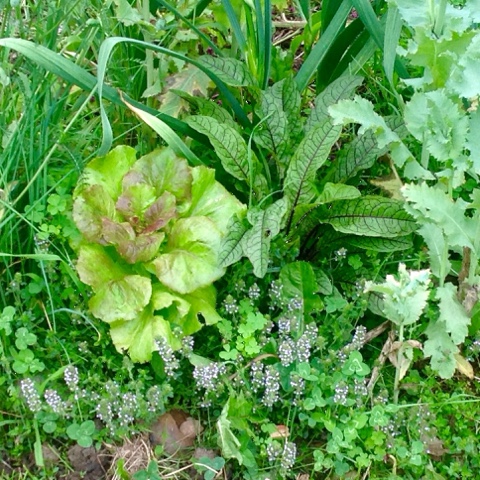This ancient culinary herb seems to change flavor significantly through the seasons, something our ancestors would have been familiar with as they used it to flavor their meals.
Since we use good Permaculture design and strategies like heavy mulching, polycultures and self-organizing plant communities, our garden doesn't require much of us, but it gives back a great deal: beauty, diverse nutritionally dense foods, fuel wood, craft materials, medicines, aromatherapy, and a deeper understanding of nature, human systems, and life itself.
But a Permaculture garden's gifts go beyond one individual or even a family. A few days ago, a man who used to live a few houses down stopped by to say how great our garden looked, and to take a few pictures on his phone. He said that we inspired him to grow edible landscaping at his new place further down the street. Now he wants to have a yard like ours and teach his grandchildren about gardening. Other neighbors yell compliments to us from the road as they pass by. We take pride in knowing that our garden is giving gifts to others in our community.
But it doesn't stop there either. We understand that when we can meet our needs directly through nature, sustainably harvesting the excess of natural systems, we lessen the burden we place on ecologies and other people. Every carrot we grow ourselves is a carrot that won't have to be grown with degrading agricultural practices, sprayed with chemicals, picked by under-paid and poorly treated workers, shipped 1,200 miles with fossil fuels--the actual US avereage for carrots, refrigerated for weeks with fossil energy, and transported home for more refrigeration. Each step along the way requires mining, the destruction of rain-forest, exploitation of humans around the world, and contributes to climate change, mass extinctions and ecosystem collapse. If I can use a little bit of my leisure time to grow a large amount of my own food, this probably has the most positive impact on the environment, community health and social justice of any single thing I can do.
We're also happy to know that, while it isn't a "native garden," a Permaculture garden is the ultimate habitat restoration garden for wildlife. Our garden is filled with a large variety of native plants--one native plant landscaper suggested we likely have a greater variety of native plants than most "native gardens" in the city! But not only does our garden produce excellent habitat on site, but far more importantly, in a Permaculture garden every single foot, even those planted with "native plants," is used for productive space. And every foot of garden space used for production inside or near a human settlement means that a much, much larger space out in "the country" doesn't have to be tilled, burned or clear-cut to meet human needs. A garden where we live gets the benefit of constant, easy human interaction making it both very energy efficient and very productive, and flourish while cooperating and sharing with nature. But a farm out in "the boonies" will have to dominate and exclude nature, take more land for the same production, and have to make up for a lack of human-scale energy with fossil fuels, heavy machinery and chemicals.
At the same time, human settlements make relatively poor wildlife habitat, since they're disjointed, lack the scale for large animals and are inappropriate for the "shy" species that are often the most endangered. So using our home gardens for production means that large, contiguous tracks of high-quality habitat far from human activity can go "back to nature." Our Permaculture garden puts both places to their "highest and best use."
Who knew that being good could taste delicious?










No comments:
Post a Comment